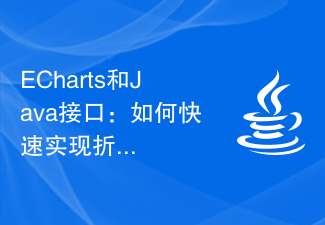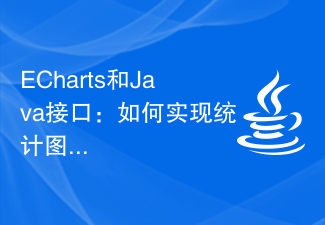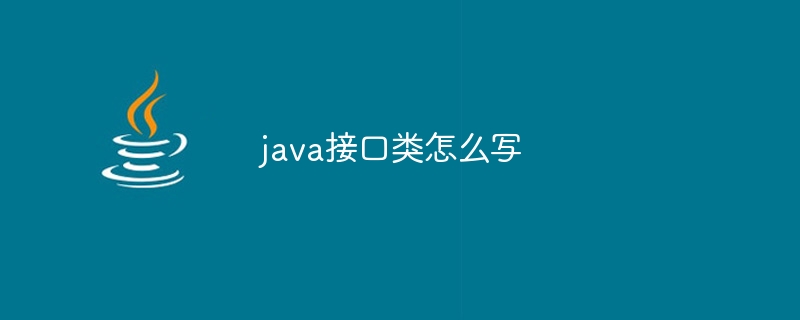 Java
Java javaTutorial
javaTutorial What is an interface in Java? Detailed explanation of the concepts and functions of Java interfaces
What is an interface in Java? Detailed explanation of the concepts and functions of Java interfaces
What is an interface in Java? Detailed explanation of the concept and function of Java interface requires specific code examples
In Java, interface (Interface) is an abstract data type that defines the specifications of a set of methods without giving a specific implementation. . An interface can be regarded as a contract. Any class that implements the interface must abide by this contract and implement all methods defined in the interface.
The interface is defined as follows:
public interface InterfaceName {
// 声明方法,没有方法体
returnType methodName(parameterList);
}The methods in the interface are public by default, so you do not need to write access modifiers when declaring. The methods in the interface have no method body, only the declaration of the method, and no specific implementation.
The main functions of the interface are as follows:
1. Declaration specification: The interface defines a set of method specifications. Through the interface, you can tell other classes which methods should be implemented. Interfaces can act as a constraint, making the code more standardized and readable.
2. Implement polymorphism: Interface allows multiple classes to implement the same interface, thus achieving polymorphism. Through interfaces, we can define a set of methods with similar functions and then use different implementation classes to implement these methods.
3. Reduce the degree of coupling: Interfaces can reduce the degree of coupling between classes. A class can implement multiple interfaces at the same time, so that it can achieve a combination of multiple functions instead of relying on a single inheritance relationship.
The following uses a specific example to illustrate the use of interfaces:
// 定义一个接口
public interface Animal {
void eat();
void sleep();
}
// 实现接口
public class Dog implements Animal {
@Override
public void eat() {
System.out.println("狗在吃东西");
}
@Override
public void sleep() {
System.out.println("狗在睡觉");
}
}
public class Cat implements Animal {
@Override
public void eat() {
System.out.println("猫在吃东西");
}
@Override
public void sleep() {
System.out.println("猫在睡觉");
}
}
// 测试类
public class AnimalTest {
public static void main(String[] args) {
Animal dog = new Dog();
dog.eat();
dog.sleep();
Animal cat = new Cat();
cat.eat();
cat.sleep();
}
}In the above example, we define an Animal interface, which defines two methods: eat and sleep. Then we implement this interface through the Dog class and Cat class. In the test class AnimalTest, we created a Dog object and a Cat object respectively, and called their eat and sleep methods.
Through the interface, we can classify the Dog class and the Cat class into one category. They both belong to the more abstract type of Animal. This design method makes the code structure clear and easy to expand and maintain. In addition, if we need to add a new animal class, we only need to implement the Animal interface, and there is no need to modify the original code.
In summary, an interface in Java is an abstract data type that defines a set of method specifications. By implementing interfaces, you can achieve polymorphism and reduce coupling between classes. The role of interfaces in Java is very important and needs to be used flexibly in actual development.
The above is the detailed content of What is an interface in Java? Detailed explanation of the concepts and functions of Java interfaces. For more information, please follow other related articles on the PHP Chinese website!
 ECharts和Java接口:如何快速实现折线图、柱状图、饼图等统计图Dec 17, 2023 pm 10:37 PM
ECharts和Java接口:如何快速实现折线图、柱状图、饼图等统计图Dec 17, 2023 pm 10:37 PMECharts和Java接口:如何快速实现折线图、柱状图、饼图等统计图,需要具体代码示例随着互联网时代的到来,数据分析变得越来越重要。统计图表是一种非常直观而又有力的展示方式,通过图表可以更加清晰地展示数据,让人们更好地理解数据的内涵和规律。在Java开发中,我们可以使用ECharts和Java接口来快速实现各种统计图表的展示。ECharts是一款由百度开发
 ECharts和Java接口:如何实现统计图表数据导出与分享Dec 17, 2023 am 08:44 AM
ECharts和Java接口:如何实现统计图表数据导出与分享Dec 17, 2023 am 08:44 AMECharts是一款功能强大、灵活可定制的开源图表库,可用于数据可视化和大屏展示。在大数据时代,统计图表的数据导出和分享功能变得越来越重要。本文将介绍如何通过Java接口实现ECharts的统计图表数据导出和分享功能,并提供具体的代码示例。一、ECharts简介ECharts是百度开源的一款基于JavaScript和Canvas的数据可视化库,具有丰富的图表
 java接口类怎么写Jan 03, 2024 pm 03:47 PM
java接口类怎么写Jan 03, 2024 pm 03:47 PM编写方法:1、定义一个名为MyInterface的接口;2、在MyInterface接口中定义一个名为myMethod()的方法;3、创建一个名为MyClass的类,并实现MyInterface接口;4、创建一个MyClass类的对象,并将其引用赋给一个MyInterface类型的变量即可。
 思考如何优化MyBatis的写法Feb 20, 2024 am 09:47 AM
思考如何优化MyBatis的写法Feb 20, 2024 am 09:47 AM重新思考MyBatis的写作方式MyBatis是一个非常流行的Java持久化框架,它能够帮助我们简化数据库操作的编写过程。然而,在日常使用中,我们经常会遇到一些写作方式上的困惑和瓶颈。本文将重新思考MyBatis的写作方式,并提供一些具体的代码示例,以帮助读者更好地理解和应用MyBatis。使用Mapper接口代替SQL语句在传统的MyBatis写作方式中,
 揭秘MyBatis:功能与特性详解Feb 25, 2024 am 08:24 AM
揭秘MyBatis:功能与特性详解Feb 25, 2024 am 08:24 AMMyBatis是一个流行的Java持久层框架,它简化了数据库操作的过程,提供了对SQL映射的控制,同时具有简单、灵活、强大的特点。本文将深入解析MyBatis的作用与特点,并通过具体的代码示例进行详细讲解。一、MyBatis的作用1.1数据库操作简化:MyBatis通过提供SQL映射文件将SQL语句与Java方法进行绑定,屏蔽了传统JDBC调用时繁琐的操作
 Java接口的完全指南:从基础到高级Jan 11, 2024 pm 04:46 PM
Java接口的完全指南:从基础到高级Jan 11, 2024 pm 04:46 PMJava接口创建指南:从入门到精通导语:Java是一种面向对象的编程语言,它提供了接口(interface)的概念来实现代码的重用和模块化。接口是一种抽象的数据类型,可以作为规范定义类的行为和结构。通过本文的指南,你将了解到如何创建和使用Java接口,并提供了一些具体的代码示例供参考。一、理解接口的概念在面向对象的编程中,接口是一种抽象的数据类型,可以定义类
 Java 接口与抽象类:通往编程天堂之路Mar 04, 2024 am 09:13 AM
Java 接口与抽象类:通往编程天堂之路Mar 04, 2024 am 09:13 AM接口:无实现的契约接口在Java中定义了一组方法签名,但不提供任何具体实现。它充当一种契约,强制实现该接口的类实现其指定的方法。接口中的方法是抽象方法,没有方法体。代码示例:publicinterfaceAnimal{voideat();voidsleep();}抽象类:部分实现的蓝图抽象类是一种父类,它提供了一个部分实现,可以被它的子类继承。与接口不同,抽象类可以包含具体的实现和抽象方法。抽象方法是用abstract关键字声明的,并且必须被子类覆盖。代码示例:publicabstractcla
 如何利用ECharts和Java接口实现基于地理位置的统计分析Dec 17, 2023 am 11:04 AM
如何利用ECharts和Java接口实现基于地理位置的统计分析Dec 17, 2023 am 11:04 AM如何利用ECharts和Java接口实现基于地理位置的统计分析随着移动设备和互联网技术的不断普及,地理位置信息已经成为了一种非常重要的数据形态。利用地理位置信息,我们可以深入了解市场、用户和资源的分布以及人们在不同地区的行为特征等信息,从而做出更精准的决策。为了利用地理位置信息,我们需要基于地图进行可视化展示,并且能对地图上的数据进行分析和处理。EChart


Hot AI Tools

Undresser.AI Undress
AI-powered app for creating realistic nude photos

AI Clothes Remover
Online AI tool for removing clothes from photos.

Undress AI Tool
Undress images for free

Clothoff.io
AI clothes remover

AI Hentai Generator
Generate AI Hentai for free.

Hot Article

Hot Tools

SAP NetWeaver Server Adapter for Eclipse
Integrate Eclipse with SAP NetWeaver application server.

PhpStorm Mac version
The latest (2018.2.1) professional PHP integrated development tool

DVWA
Damn Vulnerable Web App (DVWA) is a PHP/MySQL web application that is very vulnerable. Its main goals are to be an aid for security professionals to test their skills and tools in a legal environment, to help web developers better understand the process of securing web applications, and to help teachers/students teach/learn in a classroom environment Web application security. The goal of DVWA is to practice some of the most common web vulnerabilities through a simple and straightforward interface, with varying degrees of difficulty. Please note that this software

SublimeText3 English version
Recommended: Win version, supports code prompts!

ZendStudio 13.5.1 Mac
Powerful PHP integrated development environment





